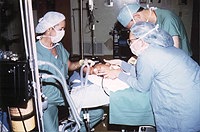 The Otolaryngologist is also known as an ear, nose, and throat
surgeon. The otolaryngologist is the physician most often
consulted for disorders of breathing, hearing, and
speech. Abnormal craniofacial development will commonly
affect one or more of these functions, and the
otolaryngologist is therefore an essential member of the
craniofacial team.
The Otolaryngologist is also known as an ear, nose, and throat
surgeon. The otolaryngologist is the physician most often
consulted for disorders of breathing, hearing, and
speech. Abnormal craniofacial development will commonly
affect one or more of these functions, and the
otolaryngologist is therefore an essential member of the
craniofacial team.
Maintenance of an adequate airway is essential in all patients and
particularly in those with craniofacial anomalies. Many
of these patients are born with facial features such as
underdeveloped upper or lower jaws or enlarged tongues
which obstruct the normal breathing passages. These
children often have difficulty feeding and growing, and
occasionally experience life threatening events due to
complete obstruction of the airway. The otolaryngologist
is the specialist trained to examine these patients.
Occasionally, endoscopy (examination of the airway with
fiberoptic and rigid telescopes) is necessary to most
accurately determine the site and severity of the
problem. Surgical correction may require a variety of
procedures including tonsillectomy, adenoidectomy,
widening of the nasal cavity, jaw advancement, tongue
reduction, and tracheotomy.
Children with craniofacial problems
are known to be at increased risk for impaired hearing.
In most cases, this is the result of chronic fluid in the
middle ear ("ear infections") resulting from
reduced ventilation through the Eustachian tube. This
tube, which connects the ear to the throat, is opened by
muscles in the palate, allowing air into the middle ear
space with such actions as yawning or swallowing. When
abnormalities of the palate or base of skull are present,
this action is impaired. The negative pressure within the
middle ear causes fluid to build-up, and clearance is
reduced since the tube will not open. The fluid thickens
and partially blocks the sound entering the ear, reducing
the ability to hear. This problem is treated by
evacuating the fluid from the ear, and placing a
"pressure equalization" tube in the eardrum to
bypass the Eustachian tube and maintain ventilation.
In other craniofacial patients,
there may be abnormal development of the outer ear, ear
canal, or hearing bones (aural atresia) or of the inner
ear (cochlea) which may be responsible for hearing loss.
In all of these children, hearing must be carefully
assessed by an audiologist and aided when necessary. The
ears must also be thoroughly examined, occasionally by
X-ray. In some cases, reconstruction of the ear and
hearing may be possible.
Abnormalities of speech in
craniofacial patients may result from impaired hearing,
but also may be due to poor palate function, abnormal
dental development, or problems relating to the voice
box. The otolaryngologist assesses all of these
functions. Frequently these patients are examined in the
presence of a speech pathologist so that function may be
compared with structure. Occasionally, a small fiberoptic
telescope may be used for more precise evaluation of
these areas. In cases where speech therapy has not
succeeded in correcting the problem, the
otolarynogologist may recommend orthodontic consultation
or surgical intervention for the throat or palate.
|